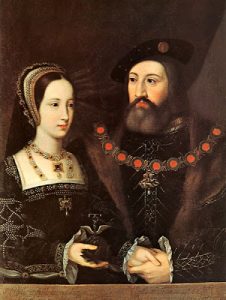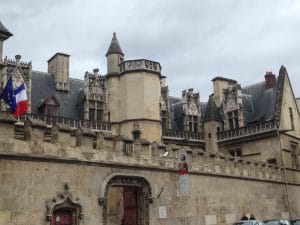 This day in history, 3rd March 1515, is one of the dates given in the contemporary sources for the secret marriage of Mary Tudor, Dowager Queen of France, and Charles Brandon, Duke of Suffolk.
This day in history, 3rd March 1515, is one of the dates given in the contemporary sources for the secret marriage of Mary Tudor, Dowager Queen of France, and Charles Brandon, Duke of Suffolk.
Mary, the younger sister of King Henry VIII, had been widowed on 1st January 1515 when her first husband, King Louis XII of France, died after less than three months of marriage. When the marriage match had been negotiated between the 18-year-old Mary and the 52-year-old Louis, Mary had made her brother, the king, promise that if she survived Louis then she would be able to marry a man of her choosing. Mary wrote to her brother reminding him of how she had fulfilled her side of their bargain by marrying the old king and now it was his turn to keep his promise: “I beseech your grace that you will keep all the promises that you promised me when I take my leave of you by the waterside” and stating that she wished to marry where “my mind is”. Her mind was set on Charles Brandon, Duke of Suffolk, her brother’s good friend and the man who her brother had sent to bring Mary back home to England.
As Erin Sadlack points out in her book on Mary’s letters, Mary actually blackmailed Henry VIII. Mary said if the king broke his promise, then she would enter a convent. If she took the veil, Henry VIII would lose control over her dower and any financial benefits from her remarrying and he wouldn’t want that to happen. However, Henry did not expect Mary to remarry secretly and without permission. Suffolk had promised Henry that the couple would not do that.
When Suffolk wrote to Cardinal Wolsey of their secret marriage, he excused his actions by making out that Mary was a damsel in distress who needed rescuing by him and that he had to marry her:
“When he came to Paris he heard many things which put him and the Queen in great fear. And the Queen would never let me [be] in rest till I had granted her to be married; and so, to be plain with you, I have married her.”
But when did this marriage take place?
Well, we don’t know for sure. A French chronicle in the Portefeuilles de Fontanieu in the Bibliothèque Nationale de France records the secret marriage taking place on 3rd March 1515, and Louise of Savoy, mother of the new French king, Francis I, records it as taking place on “le samedy, dernier jours de mars 1515”, i.e. Saturday, 31st March 1515. However, in his letter to Wolsey in which he confesses their secret marriage, Suffolk wrote “I have married her harettylle and has lyen wyet her, in soo moche [as] I fyer me lyes that sche by wyet child”. He is saying that he and Mary have consummated the marriage and that he fears that she is pregnant, so it is important for them to have a more public marriage. The letter is dated 5th March 1515 and it would be strange for Suffolk to be concerned about Mary being pregnant just two days after their marriage, so it appears that they must have married earlier than 3rd March.
If we rewind slightly, we have a record of a meeting between Francis I and Suffolk on Thursday 1 February in which the French king accused Suffolk of coming to France “to marry the Queen, your master’s sister.” Suffolk denied it, saying that it would be a “great folly” for him to come to France to marry the dowager queen without Francis’s knowledge or the permission of Henry VIII. He assured Francis that it was not his or his king’s intention. However, Francis caught him in a lie for the French king had already spoken to Mary and that she “had broken her mind unto him” and told him of the couple’s plan. Francis had said to Mary “that he would help her and d[o what was possi]ble in him to help her to obtain [her heart’s desi]re.” Suffolk then thanked the king “for the great goodness he intended to show to himself and the Queen”. Suffolk recorded this meeting in a letter to Wolsey on 3rd February 1515, written ten leagues from Paris, so we know that Mary and Suffolk were planning to marry at this point, but had not yet married. As Mary Croom Brown points out, Suffolk must have been overjoyed that the French king had pledged his support. Croom Brown writes of how Suffolk reached Paris on 4th February and that Mary sent for him. He was greeted by an emotional Mary who begged him to marry her before their return to England.
Although Francis I offered his support for the marriage, he didn’t expect the couple to marry secretly while he was trying to help them, but it appears that they did. In the “Chronicle Louis XII”, Robert III de La Marck, Seigneur of Fleuranges and Marshal of France, records Francis I’s fury at Suffolk:
“I am advertised of this thing: I did not think you had been so base, and if I chose to do my duty, I should, this very hour, have your head taken off your shoulders; for you have failed of your faith; and, trusting to your faith, I have not had watch kept over you. You have secretly, without my knowledge married Queen Mary.”
Oh dear!

What we can conclude, is that the couple married secretly sometime after 3rd February and at least a couple of weeks before Suffolk’s letter to Wolsey on 5th March, so mid-February makes sense. This secret marriage would have taken place at the chapel at the Hotel de Cluny in Paris, where Mary was staying at this time. The secret marriage was then followed by the more public marriage that Suffolk wanted, which is recorded as having taken place on 31st March 1515.
The couple returned to England on 2nd May 1515 and were married again on 13th May at Greenwich in the presence of Henry VIII and Queen Katherine of Aragon. Mary and Suffolk went on to have four children: Henry born in 1516, Frances born in 1517, Eleanor between 1518 and 1521, and a second Henry in 1522 (the first Henry having died by this time). Their marriage came to an end on 25 June 1533 when Mary died.
Notes and Sources
Pictures: Portrait of Charles Brandon and Mary Tudor by Jan Mabuse, the collection of the Earl of Yarborough; Photo of Le musée de Cluny, or the Musée national du Moyen Âge, which was known as the Hôtel de Cluny or Palais de Cluny, copyright Claire Ridgway.
- Gunn, Steven (2015) Charles Brandon: Henry VIII’s Closest Friend, Amberley Publishing.
- Everett Wood (Green), Mary (1846) Letters of royal and illustrious ladies of Great Britain, from the commencement of the twelfth century to the close of the reign of Queen Mary, H. Colburn, p. 187-188.
- Everett Wood (Green), Mary (1857) Lives of the Princesses of England, from the Norman Conquest, Volume V, Longman, Brown, Green , Longman, & Roberts, p. 89-91.
- Croom Brown, Mary (1911) Mary Tudor, Queen of France, Methuen, Chapter 8.
- Journal de Louise de Savoye, p. 397.
- Sadlack, Erin (2011) The French Queen’s Letters: Mary Tudor Brandon and the Politics of Marriage in sixteenth century Europe, AIAA.
- Strickland, Agnes (1868) Lives of the Tudor Princesses, Longmans, Green, & Co.
- Chronicle Louis XII, Du Puy MS. No. 107. Robert de la Marck, BNF, p. 239-40.
- Letters and Papers, Foreign and Domestic, Henry VIII, Volume 2, 106, 222, Suffolk to Wolsey.